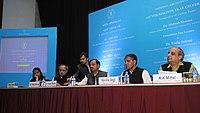 Emblem of the National Archives of India | |
 Interiors of the National Archives of India, New Delhi | |
| Agency overview | |
|---|---|
| Formed | 11 March 1891 |
| Jurisdiction | Government of India |
| Minister responsible |
|
| Agency executive |
|
| Parent department | Ministry of Culture |
| Website | http://nationalarchives.nic.in/ |
The National Archives of India (NAI) is a repository of the non-current records of the Government of India and holds them in trust for the use of administrators and scholars. Originally established as the Imperial Record Department in 1891, in Calcutta, the capital of British India, the NAI is situated at the intersection of Janpath and Rajpath, in Delhi. It functions as an Attached Office of the Department of Culture under the Ministry of Culture, Government of India.[1]
History

The Imperial Record Department was set up on 11 March 1891 in Calcutta (Kolkata). G. W. Forrest was named as department head.[2] In 1911 it was transferred to the new capital, New Delhi, and in 1926 it was shifted into its new building. This was one of four museum and archive buildings planned by its architect Edwin Lutyens around 'Point B' in the city plan, the intersection of King's Way and Queen's Way. However, only this one was built. It is a building in late neo-classical style, and originally known as the Imperial Record Office.[3]
K. R. Narayanan, then President of India, declared the "Museum of the National Archives" open to the general public on 6 July 1998. This museum provides a representative overview of the multifarious holdings of the National Archives, and promotes a common man's interest in archival holdings.
The NAI has a Regional Office at Bhopal and three Record Centres at Bhubaneswar, Jaipur and Pondicherry.
Records
The holdings in the National Archives are in a regular series starting from the year 1748. The languages of the records include English, Arabic, Hindi, Persian, Sanskrit and Urdu, and their materials include paper, palm leaf, birch bark and parchment. The records are in four categories: Public Records, Oriental Records, Manuscripts and Private Papers.
There has been a certain amount of criticism regarding the lack of care taken in preservation and handling of records.[4][5][6]
Exhibitions
The National Archives of India also holds regular exhibitions such as the display of declassified files on Subhas Chandra Bose in 2016 and the recent exhibition, "The Jammu and Kashmir Saga", commemorating 70 years of Jammu and Kashmir's accession to India which was held from 10 January 2018 to 10 February 2018.[7][8][9] Between 1973 and 2015 NAI has held 108 exhibitions on various themes.[10]
Abhilekh patal
Abhilekh patal is an online portal to access National Archives of India’s reference media and its digitized collections via the internet.[11] The name 'Abhilekh patal' comes from the Sanskrit word 'Abhilekh' meaning the records of ancient times and the word 'patal' meaning the platform, board or a surface. It is a work in progress.
Gallery
See also
- List of national archives
- List of archives in India
References
- ^ National Archives of India Government of India website.
- ^ "124th Foundation Day Celebrations of National Archives of India". PIB. 11 March 2014. Retrieved 12 March 2014.
- ^ "Architectural marvels for the new capital". Hindustan Times. July 20, 2011. Archived from the original on November 2, 2014.
- ^ Shivaram, Choodie. "How the National Archives of India Is Actually Destroying History". thewire.in. Retrieved 2018-02-06.
- ^ Dalrymple, William (2004-04-27). "Introduction". White Mughals: Love and Betrayal in Eighteenth-Century India. Penguin. pp. xlii. ISBN 9781101098127.
- ^ ...It is also clear that some of the material is missing.... https://www.thequint.com/lifestyle/books/book-excerpt-ornit-shani-how-india-became-democratic-election-democracy
- ^ "Exhibition on 70 yrs of J and K's accession to India inaugurated by Minister". United News of India (UNI). 11 Jan 2018.
- ^ "National Archives displays Sangh's stand on J&K plebiscite - Times of India". The Times of India. Retrieved 2018-02-06.
- ^ "On archival wealth". Greater Kashmir. 29 Jan 2018.
- ^ LIST OF EXHIBITIONS ORGANISED BY THE NATIONAL ARCHIVES OF INDIA - 1973 - 2015 http://www.nationalarchives.nic.in/sites/default/files/List_of_exhibitions%281973-2015%29%20%281%29.pdf
- ^ Basu, Narayani. "With archives closed, libraries out of reach, and travel stopped, how will writers research books?". Scroll.in. Archived from the original on 2020-07-15. Retrieved 2020-07-15.
Further reading
- Dinyar Patel. "Repairing the Damage at India’s National Archives." New York Times, March 21, 2012.
External links
- National Archives of India, Official Website.
- Abhilekh-Patal (Portal for access to archives & learning)


